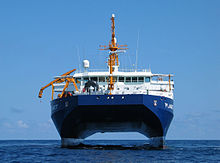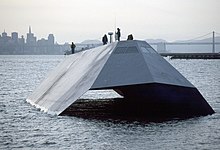Small Waterplane Area Twin Hull

The Engl. Designation Small Waterplane Area Twin Hull (SWATH), in English about double hull with a small waterline area, designates a special hull shape of ships that is particularly insensitive to rough seas . It was introduced to the British Navy in 1938 by its inventor, Frederick George Creed , for which he was granted a patent in the United Kingdom in 1946 . There are two torpedo-shaped buoyancy bodies below the surface of the water, on which a platform above the water rests by means of narrow webs or supports that form a minimal waterline surface. The SWATH ship is a special form of the catamaran . Ships that are constructed according to this construction principle are called SWATH. In Japan, the term " semi-submerged catamaran " (SSC) (German: half submerged catamaran) is common. Worldwide around 60 ships, according to other sources 100 ships, were built according to the SWATH principle by 2011.
General

The method that this hull shape uses to minimize vertical movements in swell is borrowed from semi-submersibles (design of drilling platforms). As far as possible, use is made of the fact that the wave movement, which is most violent on the water surface, decreases with increasing depth.
The desired property of this design, that swell causes the smallest possible diving movements, at the same time causes the undesirable property that diving deflections only cause very low restoring forces - the system behaves like a very soft spring. This is countered with actively controlled fins that stabilize the system while driving.
If the two propellers are arranged on the floats, there is not enough space in smaller units to accommodate diesel engines . Instead, diesel-electric drives are used, with the diesel engine in the platform above water. For larger units (from 40 m), the diesel engines ( e.g. MTU 4000 ) can be accommodated in the float.

It is planned to replace the ships of the German Federal Customs Administration - the water customs - with large SWATH-type boats in the long term.
advantages and disadvantages
advantages
The great advantage of the SWATH ships is that they lie very calmly in the water even in rough seas, which can prevent people on board from getting seasick . SWATH is therefore the suitable design for ships on which the crew has to continue working even in rough seas, or people have to transfer to platforms or other ships (for example pilots ). Due to the quiet location, this design is very well suited for research vessels that are dependent on small movements due to the launching and recording work of extensive measuring units and the use of motion-sensitive devices. It enables research activities even in rough seas. In rough seas, the SWATH concept enables higher speeds than the monohull concept, since such a ship does not pitch , that is, does not dive into the waves.
disadvantage
The advantage of smooth sailing in heavy seas is offset by the disadvantage that even small changes in the cargo lead to major changes in the draft or small changes in the center of gravity to heel the ship. If the weight changes significantly between the empty and loaded state, there is therefore the risk that the immersion bodies will partially come out of the water or that the ship will dip too deep into the water. This must be corrected by counterbalancing. The SWATH ships have a relatively large draft for their tonnage . In addition, a ship of conventional construction offers considerably more storage space .
Ships
- Duplus , a Dutch diving base ship. Probably the first SWATH ship operated in practice. Launched in 1969, demolished in 2004
- CCGS Frederick G. Creed , aCanadian Coast Guard patrol boat ; Launched in 1988
- Sea Shadow , an experimental stealth ship in the US Navy
- Sea Fighter , an experimentalUS Navy littoral combat ship
- China Star , formerly the Radisson Diamond , a 350-passenger luxury cruise ship with a GT of 20295
- Customs ships Helgoland and sister ship Borkum of the Federal Customs Administration / Water Customs , built in 2009, stationed in Cuxhaven,
- R / V Kilo Moana , a University of Hawaii research vessel
- Cloud X , a passenger ferry between Florida and the Bahamas
- Cetus and Perseus , pilot tender of the Netherlands Loodswezen
- Döse, Duhnen, Wangeroog, Borkum ( pilot transfer service in the German Bight )
- Elbe , (pilot transfer service in the German Bight)
- Planet Type 751, weapons and sonar research ship of the German Navy .
- Nekton Pilot and Nekton Rorqual , two small cruise ships for recreational divers from the US company Nekton Diving Cruises. Both ships have trim tanks in the floats and can be trimmed either for greater stability as a SWATH or for faster cruising as a catamaran.
- Silver Cloud A 41 meter yacht from Abeking & Rasmussen (A&R)
- Felicitas experimental yacht built in 1999
- USNS Impeccable (T-AGOS-23) , length 85 m; USNS Victorious (T-AGOS-19), length 72 m; US Navy surveillance vessels
- R / V Western Flyer, a research vessel from the Monterey Bay Aquarium Research Institute . But the ship showed structural problems.
- Natalia Bekker , a wind farm tender in the BARD Offshore 1 wind farm .
Web links
- SWATH @ A & R Yacht Silver Cloud (English)
Individual evidence
- ↑ www.zoll.de ( Memento from October 15, 2015 in the Internet Archive ) "Zoll aktuell" 05/09, p. 6 (PDF) - "New SWATH customs ship: The future has begun". Accessed October 30, 2009.
- ↑ [1] "Report on structural weaknesses on the R / V Western Flyer" (PDF / English; 447 kB).





